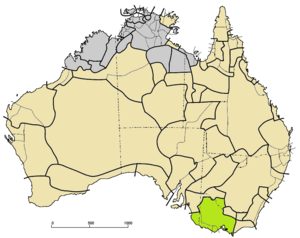Kulinic languages facts for kids
Quick facts for kids Kulinic |
|
|---|---|
| Kulin–Bunganditj | |
| Geographic distribution: |
Victoria (Australia) |
| Linguistic classification: | Pama–Nyungan
|
| Subdivisions: | |
 Kulinic languages (green) among other Pama–Nyungan (tan). Along the coast, the three groups are (west to east) Drual, Kolakngat, Kulin.
|
|
The Kulinic languages are a group of Aboriginal Australian languages. They belong to the larger Pama–Nyungan language family. These languages were traditionally spoken in the state of Victoria, in southeastern Australia.
A language family is like a family tree for languages. It shows how different languages are related to each other. The Kulinic languages are a branch of this big family tree.
Contents
Main Kulinic Language Groups
The Kulinic language family includes several important groups. These groups are like different branches on the Kulinic language tree.
The Kulin Languages
The Kulin languages are a major part of the Kulinic family. There are at least three Kulin languages. One well-known example is the Woiwurrung language. These languages were spoken by the Kulin people.
The Kolakngat Language
Kolakngat is another language in the Kulinic family. It was spoken by the Gulidjan people. This language is also known as Gulidjan.
The Drual Languages
The Drual languages form a smaller group within Kulinic. There are at least two languages in the Drual group. These languages were spoken along the coast of Victoria.
Other Kulinic Languages
Some other languages are also part of the Kulinic family, but we don't know as much about them.
Warrnambool Language
The Warrnambool language is considered Kulinic. It might be a part of the Drual group. However, there isn't enough information left to be completely sure.
Gadubanud Language
The Gadubanud language was a dialect. This means it was a different way of speaking an existing language. Gadubanud was either a dialect of Warrnambool or Kolakngat.
Interior Kulinic Languages
There are also some Kulinic languages from inland areas of Victoria. We don't have much information about them. One example is the Wemba-Wemba language.
How Kulinic Languages Are Related
Even though these languages are grouped as Kulinic, they are not very similar to each other. Imagine them as distant cousins rather than close siblings. Some experts even think they should be treated as separate language families. This shows how diverse the Aboriginal languages of Australia are.
See also
 In Spanish: Lenguas kulínicas para niños
In Spanish: Lenguas kulínicas para niños

